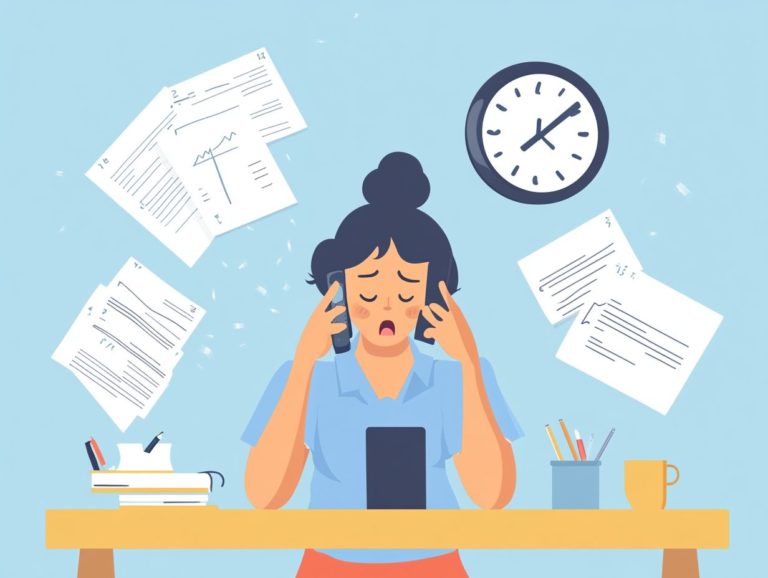How to Document Your Accident for an Insurance Claim
Dealing with the aftermath of an accident can be overwhelming, but you can tackle it with confidence. Understanding the various types of coverage available and knowing the essential steps involved can profoundly impact your experience throughout the process.
This guide will walk you through documenting your accident, filing your claim, and steering clear of common pitfalls. From collecting vital evidence to addressing potential denials, you will gain the necessary knowledge to ensure your claim is not only successful but also stress-free.
Contents
- Key Takeaways:
- Understanding Insurance Claims for Accidents
- Steps to Documenting an Accident
- How to File an Insurance Claim
- Tips for a Successful Insurance Claim
- Dealing with Denials and Disputes
- Frequently Asked Questions
- How can I accurately document my accident for an insurance claim?
- What information should I gather at the scene of the accident?
- Do I need to report the accident to my insurance company?
- What should I do if the other driver’s insurance company contacts me?
- What types of documentation should I provide to my insurance company?
- What if I am not satisfied with the insurance company’s offer for my claim?
Key Takeaways:
- Understand your insurance coverage to know what expenses are eligible for reimbursement.
- Take immediate action after an accident by gathering evidence and information to support your insurance claim.
- Be prepared for a successful insurance claim by avoiding mistakes and working closely with your insurance company.
Understanding Insurance Claims for Accidents
Understanding insurance claims for accidents is essential for anyone caught up in an incident, particularly in Georgia, where specific laws and regulations shape the claims process. Your journey starts with understanding the important steps to navigate a personal injury claim effectively.
Knowing about liability coverage and the role of insurance companies can significantly impact your compensation outcome. If you need legal representation, consider enlisting a firm like the Wetherington Law Firm. They can provide guidance to ensure that all necessary documentation is meticulously managed, giving you a fighting chance in your claims against insurers.
Types of Insurance Coverage
Several types of insurance coverage are essential for effectively handling accidents, including Bodily Injury Liability Coverage, Medical Payments Coverage, and Uninsured Motorist Coverage.
Each of these coverages plays a crucial role in safeguarding you during the often complex claims process that follows a car accident.
Bodily Injury Liability Coverage helps cover the medical expenses of injured parties if you’re at fault. This ensures victims get timely medical treatment. It also protects you from large out-of-pocket expenses.
Medical Payments Coverage provides for personal medical expenses for you and your passengers, regardless of who is at fault. This coverage can be vital for addressing immediate medical needs.
Uninsured Motorist Coverage offers protection when you encounter a driver without adequate insurance, alleviating financial strain and ensuring compensation for damages.
Together, these coverages create a safety net that fosters security and peace of mind for all registered drivers like you.
Steps to Documenting an Accident
Documenting an accident effectively is crucial for your personal injury claim, serving as the foundation for any potential legal action and insurance recovery. To ensure you cover all bases, begin by gathering essential evidence, such as photographic records of the accident scene. Additionally, knowing how to handle an insurance claim for a minor accident can streamline the recovery process.
Consider maintaining an injury diary to meticulously track your recovery journey. Don t forget to collect medical records and witness statements. Proper documentation fortifies your claim and facilitates a comprehensive injury assessment, significantly impacting the outcome of your settlement negotiations.
What to Do Immediately After the Accident
Your first step must be immediately seeking medical attention if necessary your health and safety are paramount.
Once you ve confirmed that everyone is safe, the next critical step is to contact the police and emergency responders, especially if there are visible injuries. These professionals assess the situation, provide essential aid, and create an official report that can be invaluable for insurance claims later on.
Prompt medical attention ensures that any injuries are treated and helps document them, which plays a significant role in any future claims or legal proceedings. Timely intervention can make a substantial difference in both your recovery and the accuracy of reports.
By following these steps, you will be better prepared to handle your claim successfully.
Gathering Evidence and Information
Gathering evidence and information is a crucial step following an accident. It provides essential support for your insurance claims, including understanding how to file an auto insurance claim and any potential legal actions.
Amid the chaos after an incident, it’s easy to overlook vital pieces of evidence that could sway your case. For instance, capturing photographic evidence of the accident scene helps establish the conditions, location, and any visible damages.
This creates a strong visual narrative for insurance adjusters and legal representatives to analyze. Obtaining witness statements is equally valuable; firsthand accounts lend credibility to your claim and provide crucial insights that help corroborate the sequence of events.
Don’t underestimate the importance of keeping careful records of your injuries. Document every medical treatment and progress.
These elements together not only substantiate the injuries you ve sustained but also illustrate their impact on your daily life. This ultimately enhances the strength of your personal injury claim.
How to File an Insurance Claim
Filing an insurance claim after an accident requires a systematic approach. Familiarize yourself with the necessary documents that will support your claim to navigate the claims process smoothly and effectively.
Required Documents and Forms
The documents and forms required for filing an insurance claim include:
- Medical records
- Accident documentation
- Witness statements
These documents are essential as they provide a comprehensive picture of the incident. This enables insurers to assess claims with both accuracy and efficiency.
Medical records serve as proof of injury and detail the treatments you ve received, which can influence your compensation amount.
Accident documentation think police reports and photographs offers a factual account of what transpired, helping to establish liability (who is responsible for the accident).
Witness statements further illuminate the situation, lending credibility to your version of events. Together, these components form a robust claim that streamlines the review process and enhances the likelihood of receiving the compensation you deserve.
Tips for a Successful Insurance Claim
Navigating the insurance claims process can be daunting, but you can simplify it! Adhering to essential tips can enhance your chances of a successful personal injury claim and streamline your settlement negotiations.
Avoiding Common Mistakes
Avoiding common mistakes is essential during the documentation process for insurance claims. These errors can impact the success of your claim.
Many underestimate the importance of thorough documentation, thinking that casual records will suffice. In reality, your attention to detail can mean the difference between a swift resolution and a protracted dispute.
It s vital to maintain organized records such as medical bills, accident reports, and communications with insurance adjusters. Ensure that every piece of information is accurate and complete to protect yourself against potential pitfalls.
Understanding your policy terms and asking questions when in doubt will empower you to navigate the complexities of the claims process effectively.
Working with Insurance Companies
Navigating the realm of insurance companies requires a strategic mindset to position your claim favorably during settlement negotiations.
Understanding their processes is crucial, as it can influence your claim’s outcome. Effective communication plays a pivotal role; being clear, concise, and organized can enhance your credibility.
In negotiation, focus on crafting a compelling case that underscores the validity of your claims while remaining open to dialogue.
Engaging a personal injury attorney can elevate your approach, providing valuable expertise and understanding of the legal landscape. This can strengthen your position and potentially lead to a more advantageous settlement.
They are equipped to navigate the intricate maze of insurance policies, ensuring your rights are safeguarded throughout this journey. Don’t hesitate to reach out for help!
Dealing with Denials and Disputes
Navigating denials and disputes can be one of the more challenging aspects of the insurance claims process, especially regarding personal injury claims.
Appealing a Denial
When you encounter a denial, appealing it is crucial to salvage your insurance claim and ensure your voice is heard. This process allows you to challenge the decision and present a well-organized case supported by substantial evidence.
Comprehensive documentation is vital, as it strengthens your appeal by providing clear reasons and supporting materials that can sway the insurance adjuster’s perspective. Key components to include are medical records, photographs, bills, and any relevant correspondence that underscores the legitimacy of your claim.
Depending on the outcome, you may either successfully overturn the denial or have an opportunity for further negotiations. Being prepared for discussions about the claim, its merits, and any compromises that could lead to a resolution is essential.
Mediation and Legal Options
Mediation offers a refined approach to resolving disputes that may arise during the insurance claims process, particularly in personal injury claims.
This method lets you talk openly with the other party, guided by an impartial mediator who expertly navigates your differences. It fosters open communication and cultivates a collaborative environment, allowing you to express your views while working towards mutually satisfactory solutions.
Mediation has several advantages: it tends to be cost-effective, swift, and confidential, while also having the potential to preserve relationships that could otherwise become strained during disputes. This process is particularly suitable when both parties want to negotiate in good faith but find themselves at an impasse.
If mediation does not yield a satisfactory outcome, you still have a range of legal options available. These may include pursuing formal litigation, considering arbitration as an alternative way to solve disputes without going to court, or seeking other legal remedies tailored to your case.
Frequently Asked Questions
How can I accurately document my accident for an insurance claim?
To document your accident accurately, take photos of the damages to your vehicle and others involved, along with any injuries sustained. Additionally, you should obtain a copy of the police report and gather witness statements. Following these steps to file an auto insurance claim successfully will help ensure all necessary information is collected.
What information should I gather at the scene of the accident?
At the accident scene, gather names and contact information of all parties involved, including drivers, passengers, and witnesses. Also, obtain the insurance information of the other driver(s) and note the location, date, and time of the accident.
Do I need to report the accident to my insurance company?
Yes, report the accident to your insurance company as soon as possible. This ensures that your claim is processed timely and helps protect you from potential legal issues.
What should I do if the other driver’s insurance company contacts me?
If you are contacted by the other driver’s insurance company, avoid discussing accident details or making statements without consulting your own insurance provider or a lawyer first. Also, document the name and contact information of the person who reached out to you.
What types of documentation should I provide to my insurance company?
Provide your insurance company with any documentation related to the accident, including photos, police reports, witness statements, and any medical bills or records. For more guidance, check out how to prepare for an insurance claim to include a detailed description of the accident and any injuries sustained.
What if I am not satisfied with the insurance company’s offer for my claim?
If you are unhappy with the insurance company’s offer for your claim, you may be able to negotiate for a higher settlement. Seek legal advice from a lawyer specializing in insurance claims to help you get fair compensation.
If you feel overwhelmed, consider contacting your insurance provider or seeking legal assistance to better understand your rights and options.


